
Delphinium is a genus of about 300 species of annual and perennial flowering plants in the family Ranunculaceae, native throughout the Northern Hemisphere and also on the high mountains of tropical Africa. The genus was erected by Carl Linnaeus.

Delphinium nudicaule, known by the common names canyon larkspur, red larkspur, orange larkspur, and canyon delphinium, is a flowering herbaceous perennial plant in the buttercup family Ranunculaceae. It is native to low-elevation canyons and slopes, foothills, and mountain ranges of California, US, from the Sierra Nevada to the California Coast Ranges, and of Oregon. It grows below 6,500 feet (2,000 m).

Delphinium andersonii is a species of perennial larkspur known as Anderson's larkspur. This wildflower is native to western North America, where it can be found in the Great Basin and the Sierra Nevada.

Delphinium californicum is a species of larkspur known as California larkspur. This wildflower is endemic to California, where it is a resident of the chaparral slopes of the San Francisco Bay Area and Central Coast.

Delphinium cardinale is a species of larkspur known by the common names scarlet larkspur and cardinal larkspur. This wildflower is native to California and Baja California, where it grows on coastal, inland, and desert chaparral slopes, such as the Colorado Desert, and the Peninsular and Transverse Ranges. The presence of diterpenoid alkaloids, probably including the highly toxic methyllycaconitine, in above-ground parts of D. cardinale means that they are likely to be toxic if ingested.
Delphinium decorum is a species of larkspur known by the common names coastal larkspur and yellow-tinge larkspur. This wildflower is native to California and Oregon, where it grows on the slopes of the coastal ranges from the San Francisco Bay Area north to the southern Oregon coast. It has an erect stem which approaches half a meter in height at maximum. The leaves, which are divided into a number of narrow lobes, are mostly located about the base of the plant. The spindly stem above bears two to twenty widely spaced flowers. Each flower is carried on a pedicel several centimeters long. The five long, flat sepals are extended to give the face of the flower a star shape, and they are usually deep blue to purple. The petals are similar in color, except the top two may be lighter to almost white. The spur is very thin and may be nearly two centimeters long.

Delphinium hesperium is a species of larkspur known by the common name foothill larkspur. It is also sometimes called western larkspur and coastal larkspur, but these names are less specific since other species share them. It is endemic to California, where it grows in woodland and grassland in the northern half of the state. This wildflower generally reaches one half to one meter in height. It has deeply lobed, prominently veined leaves, mostly located near the base of the plant. The inflorescence may hold very few to over 100 flowers, each on a long, thick pedicel. The flowers are usually a brilliant blue or purple, and sometimes lighter pinkish to white. Often the sepals are dark in color and the petals lighter. The spur is about one to two centimeters long.

Delphinium nuttallianum is a species of larkspur known by the common names twolobe larkspur, Nuttall's larkspur, and common larkspur. It is widely distributed across western North America from California to Alberta, including mountain meadows and the majority of the sagebrush steppe, except very dry areas.

Delphinium trolliifolium is a species of larkspur known by the common names poison delphinium, cow poison, and Columbian larkspur. It is native to Washington, Oregon, and northern California. This wildflower reaches one half to just over one meter in height. It has large, shiny, deeply lobed leaves. The top half of the stem is an inflorescence of widely spaced flowers on long pedicels, the longest over nine centimeters long. The flowers are usually deep brilliant blue. The upper two petals may be milky white. The spur exceeds two centimeters in length in the largest of the flowers. This plant is toxic as suggested by the common names, but most larkspur species are toxic to some degree.
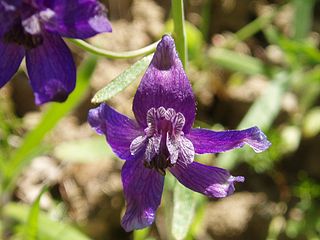
Delphinium variegatum is a species of larkspur known by the common name royal larkspur. It is endemic to California, where it grows in mountains, valley and coast in woodlands and grasslands. On the forest floor of California oak woodlands typical plant associates are Calochortus luteus, Cynoglossum grande and Calochortus amabilis.

Erythronium grandiflorum is a North American species of plants in the lily family. It is known by several common names, including yellow avalanche lily, glacier lily, and dogtooth fawn lily. The Ktunaxa name for glacier lily is maxa.

Delphinium bicolour is a species of larkspur known as little larkspur and low larkspur. It is native to northwestern North America from British Columbia to South Dakota, where it grows in mountain forests and foothill scrub and prairie. This is a perennial herb growing from a thickly branching root system. It produces solitary stems to 40 centimetres (16 in) in height and green with reddish bases. Most of the leaves are low on the stem and grow on short petioles. They are several centimeters long with many rounded lobes. The small inflorescence holds a few large flowers per stem. The flower has dark purple-blue sepals each about 2 centimeters long and a spur of 1 to 2 centimeters. The plant is poisonous to cattle, less so to sheep, and it is occasionally eaten by various species of wild cervids.
Delphinium inopinum is a species of larkspur known by the common name unexpected larkspur. It is endemic to the Sierra Nevada of California, where it is known mostly from rocky areas in open temperate coniferous forest habitat.
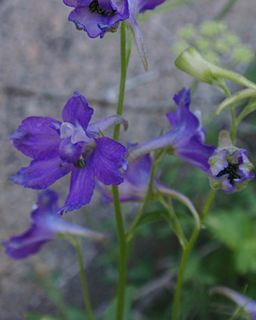
Delphinium polycladon is a species of larkspur known by the common name mountain marsh larkspur. It is native to the High Sierra Nevada and the White and Inyo Mountains of eastern California and far western Nevada, where it grows in wet sites in the talus. It is a perennial herb producing one or more erect stems which easily exceed a meter in height but often remain dwarfed in high-elevation, exposed habitat with thin soils. The leaves are small and mostly located near the base of the plant. The inflorescence is a raceme of up to 35 flowers on long, S-shaped pedicels, often arranged along one side of the stem. The sepals are deep blue to purple, one to two centimeters long, and with a spur up to 2 centimeters in length.
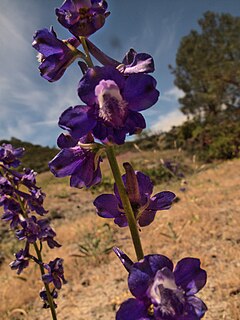
Delphinium uliginosum is a species of larkspur known by the common names swamp larkspur and bog larkspur. It is endemic to California, where it is known from very localized populations in the Inner North Coast Ranges. It grows in chaparral, grassland, and other habitat in the hills, generally on serpentine soils. This is a perennial herb producing a hairless, erect stem up to 70 centimeters tall. It can be identified by its leaves, which are fan-shaped, a characteristic unique among the larkspurs, which generally have palmate leaves with narrow, fingerlike lobes. The inflorescence bears up to 45 flowers, each on an upright pedicel which may exceed 10 centimeters long. The flower is blue with the longest sepals 1.4 centimeters long and a spur about the same length. The fruit is one or two centimeters long.
Delphinium umbraculorum is a species of larkspur known by the common name umbrella larkspur. However, its epithet does not denote an umbrella. Instead, it describes the habitat of this plant, usually shady and cool places. It is often confused with D. parryii which has similar flowers and D. patens which has similar stems and leaves. It is endemic to California, where it grows in the woodlands of the coastal mountain ranges from Monterey to Ventura Counties. It is a perennial herb producing an erect stem 40 to about 80 centimeters tall. The hairless leaves are located at the base of the plant and along the stem as well. The inflorescence bears several flowers with reflexed dark blue sepals and a spur over a centimeter long. The fruit is between 1 and 2 centimeters long.
Delphinium viridescens is a species of flowering plant in the buttercup family known by the common name Wenatchee larkspur. It is endemic to central Washington state in the United States, where it occurs in the Wenatchee Mountains in Chelan and Kittitas Counties.
Delphinium robustum is a species of flowering plant in the buttercup family known by the common names Wahatoya Creek larkspur and robust larkspur. It is native to Colorado and New Mexico in the United States.
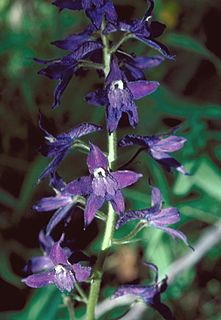
Delphinium barbeyi is a species of flowering plant in the buttercup family known by the common names subalpine larkspur, tall larkspur, and Barbey's larkspur. It is native to the interior western United States, where it occurs in the states of Arizona, Colorado, New Mexico, Utah, and Wyoming.
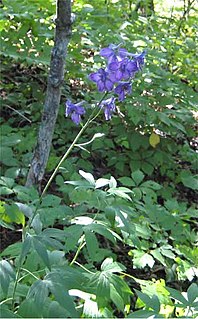
Delphinium exaltatum, known by the common name tall larkspur, is a species of flowering plant in the genus Delphinium, part of the buttercup family. Other Delphinium species are also commonly known as tall larkspur, such as Delphinium barbeyi. D. exaltatum is native to the central and eastern United States, where it can be found in Kentucky, Maine, Ohio, Pennsylvania, Maryland, West Virginia, Virginia, North Carolina, Alabama, Tennessee, and Missouri.















